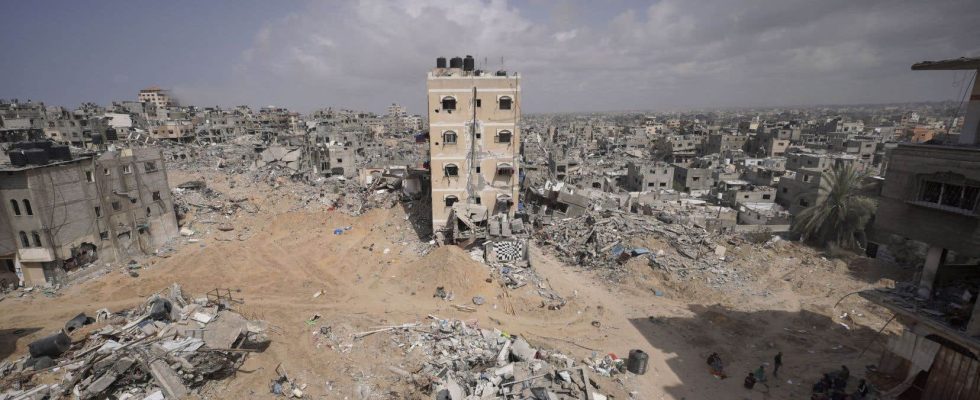International mediators are engaged in difficult negotiations on Wednesday to extract a truce agreement from Israel and Hamas in Gaza, where death and hunger are now the daily lot of the civilian population after five months of war.
Meeting in Cairo, the United States, Qatar and Egypt hope to reach an agreement before Ramadan in the devastated and besieged territory, where incessant Israeli bombings have left 86 dead in the last 24 hours, according to the Ministry of Health of Palestinian Islamist movement Hamas.
Triggered by a bloody Hamas attack against Israel on October 7, the Israeli army’s retaliatory operations have plunged the Gaza Strip into a catastrophic humanitarian crisis: 2.2 of the 2.4 million inhabitants are threatened with famine and 1.7 million were forced to flee their homes according to the UN.
Faced with this devastating war which enters its sixth month on Thursday, the United States, Israel’s main ally, is increasingly demanding a truce before Ramadan, the holy month of Muslim fasting which begins next week. .
“It’s in the hands of Hamas,” US President Joe Biden said on Tuesday, who at the same time called on Israel, which controls the entry of humanitarian aid into Gaza, to let “more aid” in. .
Hamas, whose delegation is in Cairo, accused Israel of “evading the requirements” of an agreement and assured “having demonstrated the necessary flexibility”.
A truce would be associated with a release of hostages kidnapped during the October 7 attack and still held in Gaza in exchange for Palestinians imprisoned by Israel and an entry of more aid into Gaza.
The discussions that began on Sunday in Cairo, which Israel is not attending, are “difficult” according to the AlQahera News channel, close to Egyptian intelligence.
A girl “died of malnutrition”
Hamas is demanding, before any agreement, a definitive ceasefire, a withdrawal of Israeli troops and the return of the displaced to their homes.
Israel rejects these conditions and assures that its offensive will continue until the elimination of Hamas, considered a terrorist organization by the United States and the European Union.
According to media reports, Israel is demanding that Hamas provide a precise list of hostages. But a political leader of the movement, Bassem Naïm, told AFP that his movement did not know “who is alive or dead” among them.
On October 7, Hamas commandos infiltrated from the neighboring Gaza Strip carried out an attack on southern Israel which cost the lives of at least 1,160 people, most of them civilians, according to an AFP count carried out in from official data.
Around 250 people were additionally kidnapped and taken to Gaza; 130 hostages are still being held there, 31 of whom are believed to have died according to Israel, after the release of 105 hostages and 240 Palestinian prisoners during a truce at the end of November.
In retaliation, Israel vowed to annihilate Hamas, which seized power in Gaza in 2007. Its army launched a large-scale offensive that left 30,717 dead in the Gaza Strip, mostly civilians, according to the Hamas Ministry of Health.
On Wednesday, dozens of Israeli strikes again targeted Khan Younes in the south, Gaza City in the north and Deir el-Balah, in the center of the Palestinian territory, according to Hamas authorities who report dozens of deaths daily. in Israeli bombings.
While international aid only arrives in trickles, the World Food Program has warned that hunger is reaching “catastrophic levels” in the north of the small Palestinian territory, made difficult to access by the destruction, fighting and looting.
According to the Hamas Ministry of Health, a 15-year-old girl “died of malnutrition” in this region, bringing the number of people who died of malnutrition and dehydration to 18.
“The worst I’ve seen”
In an attempt to relieve the population, Jordanian, American, French and Egyptian transport planes airdropped aid to the north of the Gaza Strip.
“Airdrops will not prevent famine,” said Carl Skau, deputy executive director of the WFP. “We need entry points into northern Gaza to deliver enough food for half a million people who desperately need it. »
“The flour (provided by the UN) is not enough. We have children who need milk. They cannot stand,” said Mohammad Abou Audeh, a displaced person from Gaza, outside a UN office in the town of Rafah where Palestinians are waiting to receive their bags of flour.
According to the UN, nearly 1.5 million Palestinians, most of them displaced, are massed in Rafah, located in the far south of the Gaza Strip against the closed border with Egypt.
Israel announced that it was preparing a ground offensive on this city to, it said, achieve “total victory” over Hamas.
For a veteran of the French NGO Handicap International, Jean-Pierre Delomier, returning from eight days and nights spent in Rafah, the situation in Gaza, where civilians are trapped under bombardments and cut off from aid, “is is the worst I’ve seen.”
